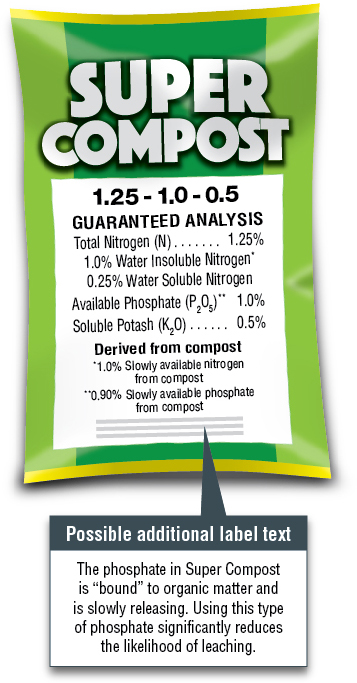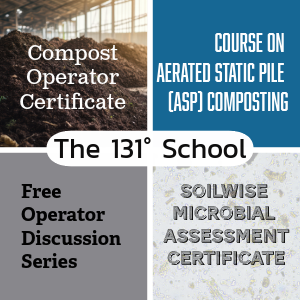Top: Working with The Pennsylvania State and Colorado State Universities laboratories (similar to one shown above), the US Composting Council proposed the Water Extractable Phosphate (WEP) test method and a definition for WEP.
Ron Alexander
Many people within the organics recycling industry — especially composters and biosolids management companies — as well as farmers and turf managers, are familiar with the concern regarding the over application of phosphorus and/or the migration of phosphorus into our water resources. Obviously, this issue should be taken seriously so we can protect drinking water, reduce surface water contamination (eutrification), and conserve an important nutrient required for plant growth (and food production). That stated, forms of phosphorus (P), such as in compost and biosolids (and certain manures), contain low levels of water extractable phosphate (WEP), but increasingly are regulated like inorganic P sources. The water extractable phosphate ranges from about 2% to 22% of the total P in compost. For background, see “Phosphorus And Compost Use Dynamics” (BioCycle, 2016).
In response to state regulations regarding phosphorus fertilizer usage, the American Association of Plant Food Control Officials (AAPFCO) developed recommended language regarding “Fertilizer Restrictions for Urban Landscapes,” as well as other related Statements of Uniform Interpretation and Policy to assist states in developing science-based regulation. Unfortunately, many states have been overzealous in their regulation, often “just going too far” (e.g., almost eliminating even maintenance applications of phosphorus on turf), while some have not dealt with more significant causes of nutrient contamination (e.g., over fertilization or manuring on agricultural land, strict enforcement of NPDES Phase II regulation [sediment control regulation during construction]). Unfortunately, many states have ignored relevant science, regulating all phosphate sources the same and ignoring their actual mobility. In many of these states, compost is impacted by these regulations if nutrient claims are made, and sometimes even when they don’t.
Distinguishing Phosphorus In Compost
For this reason, the US Composting Council’s (USCC) Industry Liaison to AAPFCO (Ron Alexander) researched a means to illustrate the difference between phosphorus in compost (and other carbon-based products) and those found in many inorganic fertilizers. In order to be able to claim that carbon-based products contain lower amounts of WEP, an acceptable lab method had to exist or be developed. These efforts led to the identification and evaluation of the SERA (Southern Extension & Research Activity) -17 WEP test method, which was originally developed for manure and biosolids. Note that several composters are already testing for WEP, especially if their product is to be used in storm water or erosion control applications, and in states that limit phosphate usage in certain turf applications. Working with The Pennsylvania State and Colorado State Universities, the USCC proposed the WEP test method and a definition for WEP. The importance of this claim relates not only to the potential negative environmental impacts of highly soluble phosphate sources, but also helps compost customers better manage nutrient addition for proper plant growth.
 At the July 2021 AAPFCO meeting, the SERA-17 test method for WEP was found to be acceptable, however sampling methods need to be further ”fleshed out” and the definition will likely go ”official” at the next AAPFCO meeting (February 2022). The definition, as it currently stands is: Water extractable phosphorous — the amount of phosphate in a carbon-based fertilizer that is readily water soluble, as determined by the SERA (Southern Extension & Research Activity) -17 test method.
At the July 2021 AAPFCO meeting, the SERA-17 test method for WEP was found to be acceptable, however sampling methods need to be further ”fleshed out” and the definition will likely go ”official” at the next AAPFCO meeting (February 2022). The definition, as it currently stands is: Water extractable phosphorous — the amount of phosphate in a carbon-based fertilizer that is readily water soluble, as determined by the SERA (Southern Extension & Research Activity) -17 test method.
The final piece of the puzzle was illustrating how testing for the WEP content of compost could be used to make slow-release phosphate claims on fertilizer labels, while following existing labeling regulations (and format). The “Super Compost” illustration seen here provides an example; note that the amount of phosphate that is not water extractable is claimed as slowly available phosphate. After some discussion, it was determined at the AAPFCO meeting that making slowly available phosphate claims for carbon-based products was in fact allowable.
How Will Composters Use This Option?
Now that testing for WEP is considered to be an acceptable way to make slowly available phosphate claims on compost and other organic recycled (carbon-based) products, product manufacturers should consider how they will use this new option. Composters, who have always known that the lion’s share of nitrogen in their product was in slowly available form, can now determine the same about phosphorus through a simple test. Perhaps more composters will register their products as fertilizers, enabling them to make legal fertilizer (nutrient) claims. Companies producing dried and granulated biosolids or manure products, which almost always register them as fertilizers, could easily make the slowly available phosphate claim once testing is completed. Similar considerations will also exist for anaerobic digestate and biochar products.
In the near-term, compost manufacturers can use this option as follows:
- If their compost is already registered as a fertilizer, they can test for WEP and make a new claim.
- If they are selling their product to farmers, turf managers and other end users depending on composts’ nutrient content, this additional testing could assist them in better helping customers manage other nutrients that may be applied along with compost.
- It could allow composters to better defend the addition of their products where environmental concerns exist, related to nutrient addition.
With WEP test data in hand, it will be important for composters to discuss phosphorus availability to certain customers in a slightly different way, but it may also allow them to make some related environmental claims. For instance, “The majority of nitrogen and phosphorus in Super Compost is in ’bound‘ form and are slowly releasing …. These types of nutrients significantly reduce the likelihood of nutrient leaching.”
The ability to discuss the fact that compost products typically contain 90% or more slowly available nitrogen and 80% or more slowly available phosphate, could help the composting industry have more meaningful discussions with environmental regulators, as well as environmentally conscious customers. With these facts understood, the risk of nutrient migration from sites where compost has been incorporated into (non-sandy) soils should be understood as minimal. Similarly, a compost blanket applied to the soil surface, and that is not heavily eroded, creates a minimal risk of nutrient migration.
Is it time for you to test your compost for WEP?
Ron Alexander is president of R. Alexander Associates, Inc. (Apex, North Carolina, 919-367-8350), a company specializing in product and market development for organic recycled products. He is author of ”The Practical Guide to Compost Marketing and Sales” (2nd Edition published by BioCycle) and has over 35 years of experience in compost and recycled organics product marketing. Mr. Alexander is a member of the US Composting Council’s Seal of Testing Assurance (Program) Advisory Committee and is an Industry Liaison to AAPFCO (Association of American Plant Food Control Officials).













